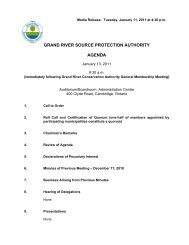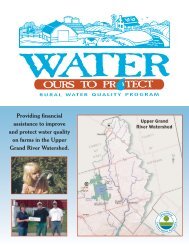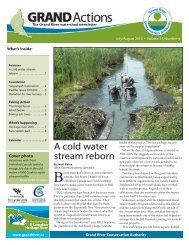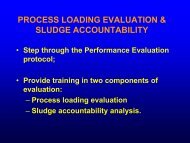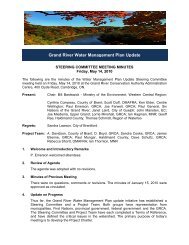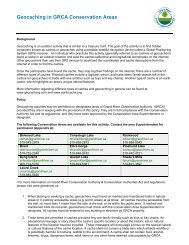Process Loading Calculations
Process Loading Calculations
Process Loading Calculations
You also want an ePaper? Increase the reach of your titles
YUMPU automatically turns print PDFs into web optimized ePapers that Google loves.
GRCA:<br />
Summarizing & Reporting Performance<br />
Measures<br />
29 Nov. 2012<br />
Purpose:<br />
To initiate voluntary annual reporting of<br />
WWTP data.
GRCA:<br />
2012 Plant Reporting:<br />
Workshop Approach:<br />
• Describe suggested approach (What?,<br />
How?) for voluntary 2012 plant reporting;<br />
• Practise associated skills (graph review &<br />
calculations);<br />
• Explain why we wish to initiate voluntary<br />
watershed-wide reporting;<br />
• Seek your advice on how to make the<br />
process effective (afternoon workshops).
GRCA:<br />
Reporting Spreadsheet Review
What’s wrong with this picture?
What’s wrong with this picture?<br />
Don’t trend together
What’s wrong with this picture?<br />
Missing data
Raw Sewage CBOD 5 ?<br />
• The BOD 5 test measures the amount of oxygen<br />
removed in a sample bottle at the end of 5-day<br />
for:<br />
– Carbon removal;<br />
– Ammonia removal.<br />
• In the cBOD 5 test, an inhibitor (a chemical) is<br />
added to prevent nitrification (ammonia removal);<br />
• The cBOD5 test is intended only for treated<br />
effluents, not for raw sewage or primary effluent;<br />
• cBOD5 results for raw sewage underestimates<br />
BOD 5 by:<br />
– ~ 20% for purely domestic wastewaters;<br />
– > 20% for significant industrial wastewaters.
Raw Sewage CBOD5? (con’t)<br />
• However: Many current CofAs<br />
specify cBOD 5 for measuring raw<br />
sewage;<br />
• In such cases, BOD 5 should also be<br />
measured to quantify true plant<br />
loading;<br />
• For GRCA annual reporting, raw<br />
BOD 5 values will be estimated as<br />
120% of cBOD5 (in the absence of<br />
other data).
<strong>Process</strong> <strong>Loading</strong><br />
“<strong>Process</strong> loading” Rate at which a substance is<br />
added (to plant or receiver):<br />
– <strong>Loading</strong> = Flow x Concentration (Units in kg/d)<br />
– <strong>Loading</strong> Plant Capacity & Sludge production<br />
– Grand River Impact on health of river<br />
Steps:<br />
1. Convert concentrations from mg/L to kg/m 3<br />
BOD 5 = 200 mg/L<br />
= 200 mg/L* 1000 L/m 3 /(1000 mg/g* 1000 g/kg)<br />
= 200/1000 kg/m 3<br />
= 0.200 kg/m 3<br />
Tip:<br />
To go from concentration in mg/L to kg/m 3 , move the decimal<br />
three places to the left:<br />
200. 200. 0.200
Practice Session<br />
Concentration<br />
(mg/L)<br />
157.<br />
Concentration<br />
(kg/m 3 )<br />
3,200.<br />
91.<br />
7.
<strong>Process</strong> <strong>Loading</strong><br />
Steps (con’t):<br />
2. Multiply Flow in m 3 /d by Concentration in kg/m 3<br />
BOD 5 = 200 mg/L = 0.200 kg/m 3<br />
Flow = 2,000 m 3 /d<br />
BOD 5 <strong>Loading</strong><br />
= Flow x Concentration<br />
= 2000 m 3 /d * 0.200 kg/m 3<br />
= 400 kg/d
Practice Session<br />
Flow Concentration <strong>Loading</strong><br />
(kg/d)<br />
1,000 m 3 /d 2 kg/m 3<br />
500 m 3 /d 4 kg/m 3<br />
2,000 m 3 /d 3,000. mg/L<br />
100 m 3 /d 12. mg/L
Questions?<br />
• If the brewery in the town closes, what will<br />
happens to BOD 5 loading to the plant?<br />
• If the plant installs a centrifuge and the centrate<br />
is returned to the head of the plant, what happens<br />
to:<br />
> BOD 5 loading?<br />
> Oxygen requirements?<br />
• During a storm at a town with a leaky sewer<br />
system, what happens to:<br />
‣ Flow to the plant?<br />
‣ BOD 5 concentration?<br />
‣ BOD 5 loading?<br />
• What is the likely impact of a sewer use bylaw on<br />
plant BOD 5 loading?
PROCESS LOADING EVALUATION<br />
(12-months of Data)<br />
Calculate/Compare per Capita flows and Load:<br />
‣ 370 L/d per person (GRCA 2010);<br />
‣ 80 g/d BOD 5 per person;<br />
‣ 90 g/d TSS per person;<br />
‣ 13 g/d TKN per person.<br />
Calculate ratios:<br />
‣ Peak Day/Annual Avg Flow: 2.5-3.5<br />
‣ TSS/BOD 5 : 0.8 – 1.2<br />
‣ TKN/BOD 5 : 0.1-0.2
Exercise<br />
Background:<br />
• Plant is a 700 m 3 /d extended aeration package plant<br />
• Typically staffed less than 4 hours per day<br />
Data (for 12-month period):<br />
• Population served = 1065<br />
• Annual average plant flow = 573 m 3 /d<br />
• Peak day flow = 2,979 m 3 /d<br />
• Average raw BOD 5 = 98 mg/L = _____ kg/m 3<br />
• Average raw TSS = 142 mg/L<br />
Reference Information:<br />
• Per Capita Flows = 370 L/person.d<br />
• Ratio: Peak Day Flow: Annual Average Flow = 2.5 – 3.5<br />
• Per Capita BOD5 <strong>Loading</strong> = 80 g BOD 5 /person.d<br />
• Ratio: TSS:BOD5 = 0.8-1.2<br />
• 1 m 3 = 1000 L<br />
• 1 kg = 1000 g
Questions?<br />
1.) Calculate per capita flow to plant (in<br />
L/person.d) and compare to typical:<br />
Per capita flow (L/person.d)<br />
= flow (m 3 /d)x 1000 L/m 3 / population<br />
= 573 m 3 /d x 1000 L/m 3 / 1065 persons<br />
= 538 L/person.d<br />
Typical = 370 L/person.d<br />
Therefore, reported plant flows are greater<br />
than typical
Questions?<br />
2.) What percentage is the annual average<br />
flow of the plant’s nominal design flow:<br />
Percent of nominal design flow<br />
= annual average flow/ nominal design flow<br />
*100%<br />
= 573 m 3 /d / 700 m 3 /d * 100%<br />
= 82%
Questions?<br />
3.) Calculate the ratio of peak day flow to<br />
annual average flow & compare to typical:<br />
Peak day flow: annual average flow<br />
= peak day flow/ annual average flow<br />
= 2,979 m 3 /d / 573 m 3 /d<br />
= 5.2<br />
Typical = 3.5-4.5<br />
Therefore, reported ratio is greater than<br />
typical
Questions?<br />
4.) Calculate average per capita BOD 5 loading (in<br />
g/person.d) to the plant and compare to typical<br />
Per capita BOD 5 loading (kg/person.d)<br />
= flow (m 3 /d) x concentration (kg/m 3 )/population<br />
= 573 m 3 /d x 0.098 kg/m 3 / 1065 persons<br />
= 0.053 kg BOD 5 /person.d<br />
Per capita BOD 5 loading (g/person.d)<br />
= 0.053 kg BOD 5 /person.d x 1000 g/kg<br />
= 53 g BOD 5 /person.d<br />
Typical = 70 – 90 g BOD 5 /d<br />
Therefore, plant’s per capita BOD 5 loading is less<br />
than typical
Questions?<br />
5.) Based on the population and the typical per capita<br />
BOD 5 loading, estimate the raw BOD 5 ( in mg/L).<br />
Estimated BOD 5 loading (kg/d) =<br />
= Population x Per Capita BOD 5 loading (g/person.d) /1000 (g/kg)<br />
= 1065 persons x 80 g/person day /1000 g/kg<br />
= 85.2 kg/d BOD 5<br />
Flow = 574 m 3 /d<br />
Estimated Concentration (kg/m 3 )<br />
= Estimated load (kg/d) / flow (m 3 /d)<br />
= 85.2 kg/d / 573 m 3 /d = 0.149 kg/m 3<br />
Estimated Concentration (mg/L)<br />
= Estimated concentration (kg/m 3 ) x 1000 (mg/L/kg/m 3 )<br />
= 0.149 (kg/m 3 ) x 1000 (mg/L/kg/m 3)<br />
= 149 mg/L BOD 5
Questions?<br />
6.) Calculate the ratio of raw TSS<br />
concentration to the raw BOD5<br />
concentration:<br />
TSS: BOD5<br />
= TSS/ BOD5<br />
= 142 / 98 m 3 /d<br />
= 1.4<br />
Typical = 0.8-1.2<br />
Therefore, reported ratio is greater than<br />
typical
SUMMARY<br />
Parameter Value Typical<br />
Per capita flow<br />
(L/person.d)<br />
% Nominal Design<br />
Peak: Avg Flow<br />
Per Capital BOD5<br />
(g/d per person)<br />
TSS: BOD5
SUMMARY<br />
Parameter Value Typical<br />
Per capita flow<br />
(L/person.d)<br />
538 370<br />
% Nominal Design 82% --<br />
Peak: Avg Flow 5.2 3.5-4.5<br />
Per Capital BOD5<br />
(g/d per person)<br />
53 80<br />
TSS: BOD5 1.4 0.8-1.2<br />
At Your Table:<br />
• What are your preliminary conclusions about this plant?<br />
• What additional information would you seek to help verify your<br />
preliminary conclusions?
Suggested Response<br />
Preliminary Conclusions:<br />
• The plant is subject to I/I as per capita flows and ratio<br />
of peak: average flows are high.<br />
• The raw BOD5 concentrations appear to be low as<br />
the per capita BOD5 loading is low & the TSS:BOD5<br />
ratio is high.<br />
Follow-up information:<br />
I/I:<br />
• Review graph of monthly average and peak flows<br />
• Water production per capita.<br />
• Does the town have an I/I program?<br />
• Does the town experience basement flooding?<br />
• How old is the sewer system?
Low raw BOD5:<br />
Suggested Response (con’t)<br />
• What are the raw TKN concentrations and hence the<br />
TKN/BOD 5 ratio?<br />
• How many samples are collected per month?<br />
• How are the raw samples collected (grab vs<br />
composite vs. flow proportioned composite), how<br />
often, and when?<br />
• Who analyzes the samples and how are the samples<br />
preserved?
Approach Summary<br />
For each facility for the 12-month period (Jan. –<br />
Dec. 2012):<br />
• Input data into spreadsheet provided<br />
(background, flows, concentrations);<br />
• Review the graphs (missing data, trends,<br />
compliance status, etc.)<br />
• Prepare “process loading evaluation” calculations<br />
& input in spreadsheet;<br />
• Compare to typical values;<br />
• Review with staff internally;<br />
• E-mail Mark Anderson the completed spreadsheet<br />
for compilation into a watershed roll-up
Why do this?<br />
• To develop & practise skills in summarizing,<br />
displaying & interpreting data;<br />
• To demonstrate how to upgrade reporting practices;<br />
• To quantify year-to-year changes loading to Grand<br />
River;<br />
• To identify issues for discussion with MOE (i.e. raw<br />
cBOD 5 ) ;<br />
• To develop approaches which could serve a model<br />
for other areas;<br />
• To help prioritize plants for follow-up optimization<br />
activities.
Along the way:<br />
Something really wild about these<br />
calculations. Should we give Mark a call?
Comments or Questions?



